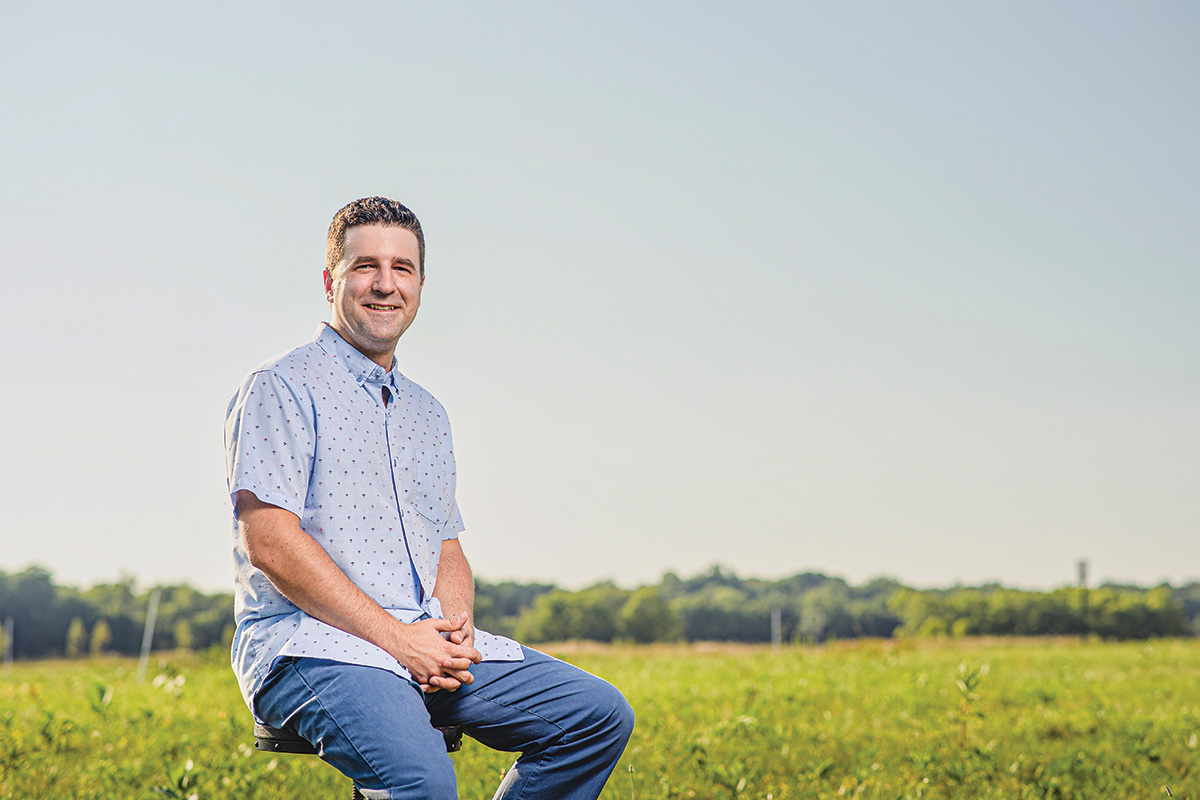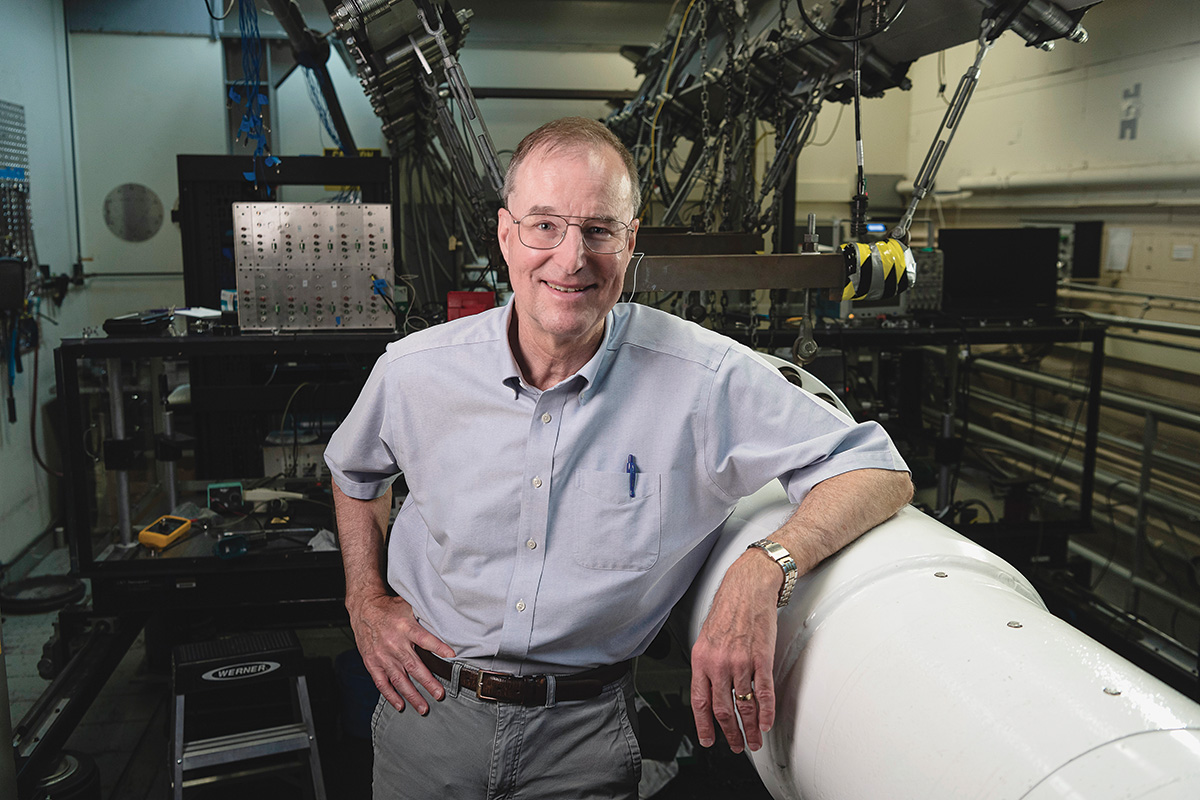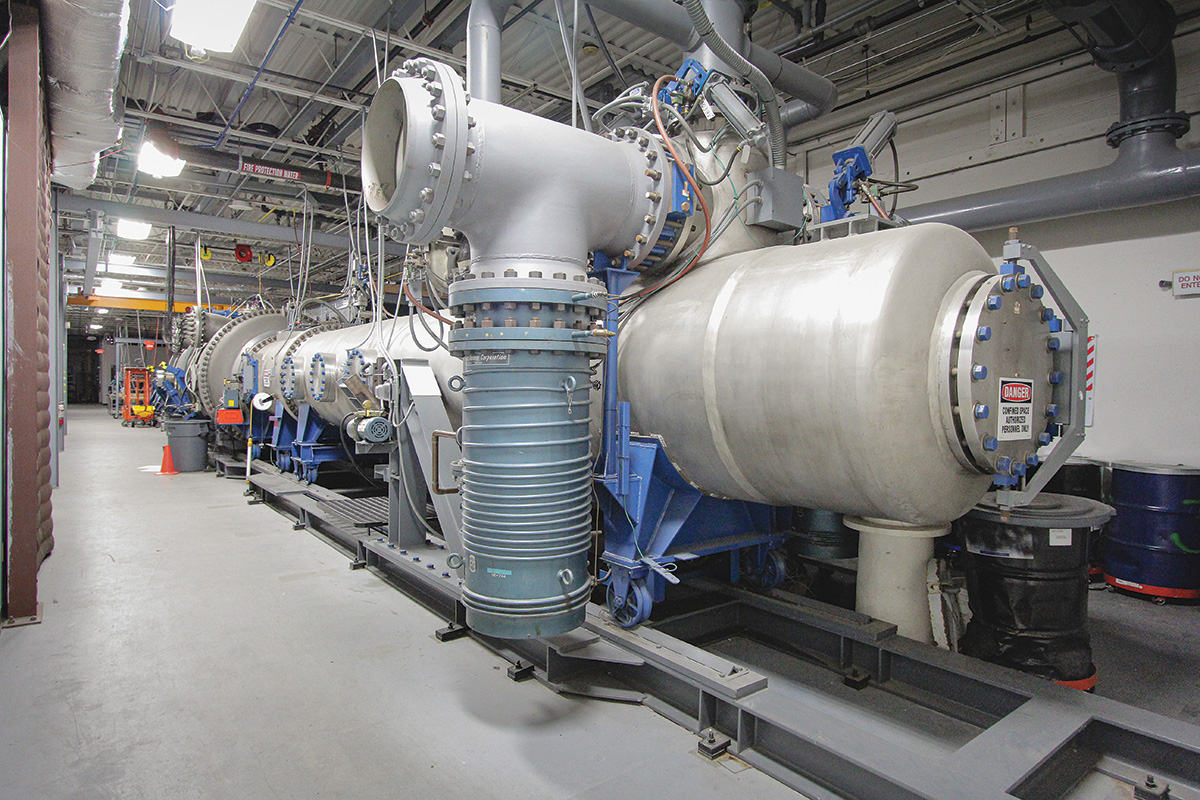
Wide open land, filled with tall grass, weeds, crickets and a patch of large bushes and trees.
In August 2021, when Brandon Chynoweth walked in an indistinctive field near Maurice J. Zucrow Laboratories in the Aerospace District for a photo shoot, there could only be visions of what the vast land would become: One of the foremost research facilities for hypersonic test and evaluation in the world, designed to function at multiple security levels in handling proprietary research collaborations with government and industry.
Only five months earlier, the Executive Committee of the Purdue University Board of Trustees, acting on behalf of the full board, approved University planning, financing, construction and awarding of construction contracts for a new facility to house two hypersonic wind tunnels.

Research Assistant Professor Brandon Chynoweth (MSAAE '15, PhD AAE '18) was tapped to design, develop and run the new Mach 8 quiet wind tunnel that'll be housed at the new Hypersonics and Applied Research Facility in Purdue's Aerospace District. Photo by - Rebecca McElhoe, Purdue University.
By November 2021, officials had broken ground on the Hypersonics and Applied Research Facility.
By 2023, the 65,000-square-foot, $41-million space is expected to be completed. It'll house the Hypersonic Pulse reflected shock/expansion tunnel (HYPULSE), donated by Northrop Grumman Corporation, and a newly developed and constructed Mach 8 quiet tunnel, which will be the first of its kind capable of collecting data at speeds greater than Mach 6.
The combination of two unique wind tunnel facilities in one state-of-the-art building will further separate Purdue from its peers in hypersonics research.
HYPULSE operates at high temperatures with a high-disturbance flow and will allow flight simulations at speeds ranging from Mach 5 to as high as Mach 40, while the Mach 8 quiet tunnel will be low temperature but have a unique low-disturbance test environment.
Because no one wind tunnel can truly simulate all areas of flight, by putting those capabilities together in one space, "this gives Purdue the ability to simulate both of the most challenging aspects of hypersonic aerodynamic testing on the ground," said Joseph Jewell, an assistant professor in AAE.
"It's easier to build a tunnel that's cold and high disturbance. Many universities have tunnels like that," Jewell said. "Knocking out either one of those, making it either low disturbance, like the atmosphere, or hot, like realistic re-entry or hypersonic flight in the atmosphere, that gets more difficult. So now at Purdue, adding HYPULSE and having the existing Mach 6 quiet tunnel and the new Mach 8 quiet tunnel, we'll be able to do both of those things. It's a big deal.
"With the full suite of capabilities we have now, we'll be able to do things that no other university can do."
Purdue's reputation in hypersonics is the main reason why it is here, on the verge of exclusivity, and why it continues to establish itself as a hub of hypersonic capabilities research.
"This facility will ensure that Purdue remains at the forefront of universities conducting research in hypersonics that will support national security needs and other efforts, like atmospheric re-entry of spacecraft or reducing the time for intercontinental travel to just a few hours," said Matt Folk, CEO and president of the Purdue for Life Foundation. "We are grateful to the Indiana Congressional delegation that has supported Purdue's efforts in hypersonic research over the past several appropriation cycles and continues to help build this strength statewide.
"Like so many of the outstanding research facilities at Purdue, naming gifts and other financial support from our friends will ensure that the Hypersonics and Applied Research Facility is world class from the first day it opens and into the future."
After the Cold War, when financial support for hypersonic research was nearly non-existent, AAE Professor Steven Schneider never stopped studying highspeed laminar-turbulent transition. In the early 1990s, he chose to persistently pursue a difficult and challenging idea: Measurements of hypersonic instability and transition in a newly developed low-noise "quiet" wind tunnel.

AAE Professor Steven Schneider's experience in designing, developing and building Purdue's Boeing/AFOSR Mach 6 Quiet Tunnel is a big reason the Air Force Research Lab approached Purdue with the task of designing and building the new quiet tunnel; Photo by - John Underwood, Purdue University.
He designed, developed and built Purdue's Mach 6 quiet tunnel, funded by the Air Force Office of Scientific Research, the Ballistic Missile Defense Organization and The Boeing Company, and even though it took five years before it was operational as a quiet tunnel at high Reynolds numbers, his determination paid dividends. Then and now.
The Mach 6 tunnel still is currently one of only two working Mach 6 quiet tunnels in the country, more than 15 years after it started operating at quiet conditions.
So it's no surprise when the Air Force Research Laboratory was looking for someone to develop a Mach 8 quiet tunnel, it approached Purdue and Schneider. By summer 2019, Purdue was awarded two contracts totaling almost $10 million to design and build it.
"I think my credibility within the Department of Defense and the work that's been done in quiet tunnels over the last three or four decades, since before I started doing it, has all contributed to the Congress and the Defense Department seeing the value in trying to build a newer and better such facility at Purdue," Schneider said.
"I started working on quiet tunnels in 1990. I spent years learning from NASA Langley, who had spent two decades previous to that working on them. I'm thankful for the opportunity to try to build another one, and I'm also looking for young faculty who are interested in picking up that baton as I need to start passing it to somebody younger who's going to be around for longer."
To that end, Schneider approached one of his former graduate students, Brandon Chynoweth, and asked if Chynoweth would be willing to take on the project of designing, developing and running the new tunnel.
Chynoweth (MSAAE '15, PhD AAE '18) was stunned. And excited. "I've always wanted to design a wind tunnel. Usually you're retrofitting old tunnels. You don't get to design a new facility often, so I hopped at the opportunity," said Chynoweth, co-principal investigator with Schneider on the project. "To have Steve as the senior advisor on the project and be able to build basically what he had always hoped to build during his career was an opportunity I couldn't pass up."
Since, Chynoweth has worked closely with Schneider, calling the long-tenured professor a valued mentor and world expert. They've been able to leverage Schneider's experience of planning, designing, constructing and using the Mach 6, as he shared a list of things that might cause the new tunnel not to achieve quiet flow.
It's not an identical process — the Mach 8 development is more challenging because it operates at higher temperatures, above 800 degrees F. That produces a new problem: The nozzle is polished like a mirror, but at elevated temperatures, metals begin to oxidize. That surface oxidation, or corrosion, leaves a roughness that could cause flow to be turbulent on the nozzle wall, completely inhibiting quiet flow operation.
It has been a difficult task figuring out which metals don't corrode at high temperatures, Chynoweth said.

By 2023, the 65,000-square-foot, $41-million Hypersonics and Applied Research Facility is expected to be completed. It'll house the Hypersonic Pulse reflected shock/expansion tunnel (HYPULSE), donated by Northrop Grumman Corporation, and a newly developed and constructed Mach 8 quiet tunnel, which will be the first of its kind capable of collecting data at speeds greater than Mach 6; Photo by - Purdue University
"It's exciting it's getting built, but we know that even though it's all put together, that's the end of construction but just the beginning of achieving a quiet flow environment," Chynoweth said. "We're trying to do as much research as we can to build this test facility for the Department of Defense and its contractors to use and also for some basic research work as well. But it's a research project. There are challenges. There are unknowns. There are risks we can only buy down so far before we have to make a really tough choice.
"So it's a juxtaposition of being excited and up at night thinking, 'What is going to be the one thing that stops this?' Because it only takes one nick in the nozzle or one thing going wrong for it to not work as a quiet tunnel."
Schneider knew the detail-oriented Chynoweth fit the mold of tackling such a task by seeing him build relationships with customers during a number of tests in the Mach 6 tunnel over the last several years. He implicitly trusts the now-research assistant professor with the monumental task of getting the tunnel not only operational but running quietly smoothly.
That "quiet" element is key, and it's what makes Purdue's tunnels special.
Quiet wind tunnels more closely simulate flight and provide more accurate data than conventional hypersonic wind tunnels. A better understanding of when and how airflow over a surface changes from smooth, or laminar, to turbulent is essential in the successful design of expendable and reusable hypersonic vehicles. Collecting data at higher Mach numbers is critical to extending the understanding of flow physics, especially heat transfer and flight control effectiveness, as DOD programs continue working to fly faster and farther.
The Mach 8 quiet tunnel will provide measurements that can be used to better inform computational simulations. Schneider, Chynoweth and Jewell, who will oversee basic research work in the tunnel, expect customers to be steady and consistent once the tunnel is operational, which Chynoweth said could happen as soon as late 2023. From there, it could be two to five years until it's quiet at a substantial Reynolds number.
"Getting quiet flow at high enough pressure that you can make meaningful measurements, that's the big thing," Chynoweth.
If quiet flow can be achieved, it'd be a game changer for Purdue, allowing measurements no one has ever seen. And they'd matter, Schneider said.
"If we can be successful, we will have made a substantial contribution to national defense," Schneider said. "That's a good thing for the national defense, which is also good for Purdue to be a national leader in something that's important to the country. It's good for the state of Indiana.
"If we can be successful, we can do things that have never been done before and make a contribution to defending freedom."
Unlike the Mach 8 quiet wind tunnel that's being developed from scratch, HYPULSE should be operational more quickly. That's because the 150-foot-long tunnel, which was disassembled for the trip from New York to Indiana, already was a working tunnel.
The tunnel has been enhanced and expanded a couple of times since the 1960s, Jewell said, but there is more to do.
Purdue will upgrade much of the instrumentation, and the control mechanisms will be redone to modern standards so it can be controlled primarily from a computer instead of physically having valves turned.

Unlike the Mach 8 quiet wind tunnel that's being developed from scratch, HYPULSE should be operational more quickly. That's because the 150-foot-long tunnel, which was disassembled for the trip from New York to Indiana, already was a working tunnel; Photo by - Northrop Grumman
"I think toward the end of when the building is getting done, the bigger parts of HYPULSE can be moved in and assembled, probably at the same time," Jewell said. "I would expect we'll be able to run it within a few months of the building being completed, simply because all we have to do is put it together, really."
An important element in the new building will be the laser room next to HYPULSE, allowing cutting-edge high-speed optical measurements to be taken, Jewell said.
Once HYPULSE is installed and operational, Purdue will be only the second university in the U.S. to offer such a comprehensive hypersonic test capability.
HYPULSE will allow flight simulations at speeds ranging from Mach 5 to as high as Mach 40 and will be useful for testing by researchers from academia, industry and government. Collecting data at higher Mach numbers and temperatures is critical to extending the understanding of flow physics, especially heat transfer and flight control effectiveness.
Reflected shock/expansion tunnels like HYPULSE use shock waves to create a reservoir of high pressure, high-temperature gas — briefly reaching temperatures as high as 16,000 degrees F — that is then expanded through a nozzle at high speeds, reaching velocities of 15,000 mph or higher for very short periods of time, from a thousandth to a hundredth of a second.
The high-speed tests recreate high-speed flight scenarios, such as spacecraft re-entry or missile flight through the atmosphere, as well as replicate unique engine conditions for extremely high-speed propulsion.
"With HYPULSE, we'll have access to higher Mach numbers, faster velocities and higher temperatures than we have previously been able to work with at Purdue," Jewell said. "This expands Purdue's hypersonics capabilities to everything short of actual flight tests. This will open up a whole new area of aerodynamic research for us."
Jewell will focus on aerodynamics testing programs in the facility, while AAE Associate Professor Carson Slabaugh will work with propulsion projects.
"Very few experimental facilities can replicate these conditions," Slabaugh said. "In the university environment, we can be very agile, working on different projects with government and with industry. We're researchers, keen to understand the fundamental flow physics at relevant flight conditions."
Cleared for public release by the Air Force Research Lab, Case Number AFRL-2021-3046
For information on naming rights for the Hypersonics and Applied Research Facility, contact Rita Baines, chief development officer, at rlbaines@purdueforlife.org or 765-494-9124.